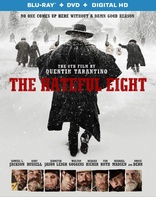The Hateful Eight Blu-ray Movie
HomeThe Hateful Eight Blu-ray Movie 
Blu-ray + DVD + UV Digital CopyStarz / Anchor Bay | 2015 | 168 min | Rated R | Mar 29, 2016
Movie rating
7.9 | / 10 |
Blu-ray rating
| Users | 3.9 | |
| Reviewer | 4.0 | |
| Overall | 3.9 |
Overview
The Hateful Eight (2015)
In post-Civil War Wyoming, bounty hunters try to find shelter during a blizzard but get involved in a plot of betrayal and deception.
Starring: Samuel L. Jackson, Kurt Russell, Jennifer Jason Leigh, Walton Goggins, Demián BichirNarrator: Quentin Tarantino
Director: Quentin Tarantino
| Dark humor | Uncertain |
| Period | Uncertain |
| Thriller | Uncertain |
| Western | Uncertain |
| Mystery | Uncertain |
Specifications
Video
Video codec: MPEG-4 AVC
Video resolution: 1080p
Aspect ratio: 2.75:1
Original aspect ratio: 2.75:1
Audio
English: DTS-HD Master Audio 5.1 (48kHz, 24-bit)
Spanish: Dolby Digital 5.1 (448 kbps)
Subtitles
English SDH, Spanish
Discs
50GB Blu-ray Disc
Two-disc set (1 BD, 1 DVD)
UV digital copy
DVD copy
Packaging
Slipcover in original pressing
Playback
Region A (locked)
Review
Rating summary
| Movie | 4.0 | |
| Video | 5.0 | |
| Audio | 4.5 | |
| Extras | 1.0 | |
| Overall | 4.0 |
The Hateful Eight Blu-ray Movie Review
Agatha Christie's Mannix?
Reviewed by Jeffrey Kauffman March 23, 2016Decades before Joan Hickson picked up a pair of knitting needles as Miss Marple or David Suchet donned a fussy little mustache as Poirot, and indeed almost a decade before Margaret Rutherford started her run as Miss Marple in Murder She Said..., Agatha Christie fans had begun flocking to what ultimately became the longest running play in history, The Mousetrap. Christie fans wanting something other than a book or short story to read had already had their mystery appetites whetted with And Then There Were None, a film which (at least somewhat like The Mousetrap) posited a group of people gathered together in an isolated location, with murder on the mind of at least one of them. (Christie’s works are mystery perennials of course, and And Then There Were None just got remade for television.) But aside from some lesser known plays and television outings, and very occasional feature films like 1957’s Witness for the Prosecution, it was The Mousetrap that tended to be the paradigmatic (non literary) Christie mystery for thousands of fans. Quentin Tarantino may have initially talked about The Hateful Eight as a follow up (if not exactly a tried and true sequel) to Django Unchained, and then subsequently as a throwback to television westerns of yore (think Bonanza), but in at least some ways, this is a film built out of blocks quarried from the Christie tradition, especially works like The Mousetrap and And Then There Were None, as in fact Tarantino has mentioned.
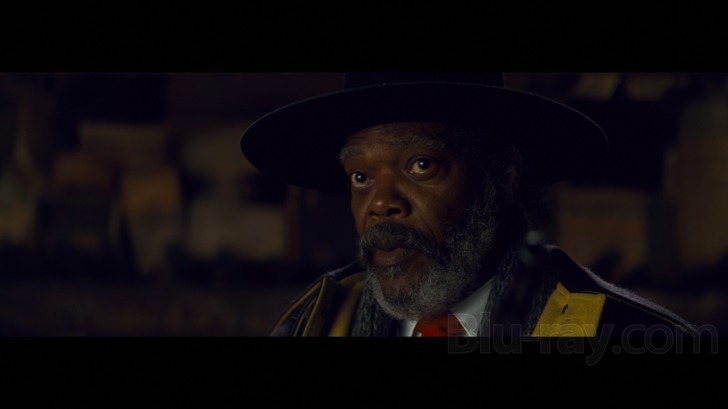
Is there another filmmaker who both honors tradition and tweaks its nose (sometimes rather viciously) as consistently as Quentin Tarantino does? Both of those proclivities are very much on display throughout The Hateful Eight, both in terms of the plot and even in terms of some production data points. Tarantino shot The Hateful Eight on 65mm (for a 70mm theatrical presentation) using Ultra Panavision lenses that (according to a short supplement included on the Blu-ray) hadn’t been utilized since Khartoum , certainly one indication of how aware of film history Tarantino has always been. Tarantino is on hand in this same supplement detailing how he knew it wasn't going to be feasible to open the film "wide" (no pun intended) since so few theaters are still equipped to handle 70mm, which is one reason he decided on a so-called roadshow version (in 70mm) to be followed by a general release version featuring 35mm reduction prints (which were also shorn of around 20 minutes of running time).
That said, this “widest” of widescreen aspect ratios would seem to be perfect for a film set in the wide open spaces of 19th century post-Civil War America, and yet—aside from a relatively short prelude which introduces several characters outdoors and few later interstitial sequences that get the film out and about into the elements, most of The Hateful Eight takes place in rather confined, at times even claustrophobic, spaces. From a purely narrative standpoint, Tarantino’s screenplay seems to be trafficking in at least some traditional mystery tropes when there are a number of post-modern elements which repeatedly gurgle up and smack the viewer in the kisser with about as much force as bounty hunter John Ruth (Kurt Russell, doing a nice John Wayne idiolect) whacks his prisoner Daisy Domergue (Jennifer Jason Leigh, Academy Award nominated for her rather remarkable performance).
Ruth and Domergue are in fact two of the characters introduced in the film’s opening moments, which take place in a wintry wilderness where a stage hired by Ruth is transporting the pair to Red Rock, Wyoming, where Ruth, who is known by the nickname The Hangman, plans to deliver Domergue to the authorities, collect his $10,000 bounty, and then stick around to (in his words) hear Domergue’s neck snap at the end of a rope. The stage is brought to a halt when another bounty hunter named Major Marquis Warren (Samuel L. Jackson) blocks the way forward—with a pile of dead bodies he wants to transport to Red Rock to collect his bounty. In one of several probably too convenient coincidences, it turns out Warren and Ruth know each other, if only informally, and after a brief moment of suspicion, Ruth allows Warren to hoist his “haul” onto the top of the stagecoach and join him and Domergue inside the carriage.
By the time a second interloper shows up to temporarily halt the stage, things might seem to be getting overly contrived, especially when it turns out that once again Ruth is at least aware of the identity of the new intruder, a rabble rouser named Chris Mannix (Walton Goggins). Mannix, in yet another convenient coincidence, informs Ruth and Warren that he’s on his way to Red Rock himself, where he’s been appointed the new sheriff. Ruth finds this somewhat hard to believe, but allows Mannix to join the troupe. Meanwhile, a nasty blizzard is descending all around the travelers, and they seek refuge in a wayside called Minnie’s Haberdashery, which is where the bulk of the film plays out.
It’s also here that some more overt references to Christie’s canon start cropping up, albeit in typically altered Tarantino-esque forms (and it’s here that those familiar with Christie’s work may be able to read between some lines and divine some “spoilers”, so forewarned is forearmed). When a worker named Bob (Demián Bichir) meets the stage and informs them that Minnie is away visiting family, suspicious viewers may already have an inkling that everything is not as it might seem (Poirot fans who remember The Labors of Hercules from Poirot: Series 13 may have a leg up in this regard). Also on hand are Sanford Smithers (Bruce Dern), a seemingly addlepated former Confederate General; Joe Gage (Michael Madsen), a laconic cowboy; and Oswaldo Mobray (Tim Roth), a natty but somewhat slimy sort whose occupation might be a potent form of foreshadowing (and one certain to cause the already battle scarred Domergue to worry even more).
Tarantino’s love of florid dialogue scenes has already stuffed this film to overflowing, even before bodies start dropping with alacrity and it becomes apparent that there may be something afoot at Minnie’s Haberdashery that involves one of its temporary residents. This turns out to be both a good thing and a bad thing for the overall trajectory of the film. Christie’s mysteries were often noted for their economy, where hosts of background information and previously hidden interconnections were often revealed in just a sentence or two, typically in the traditional “Moishe the Explainer” sequence which often cropped up in the closing moments of any given tale. But here Tarantino spends a lot (as in a lot) of screentime detailing various conflicts between the characters, something that only tends to highlight what are obvious red herrings and which keep suspense from building very consistently. On the plus side, these frequent sidebars turn out to be the most colorful thing about the film, for when push comes to shove, the actual “mystery” is almost mind numbingly easy to figure out, especially for those used to Christie tropes which often include elements like imposters or hidden relationships between characters.
There are a number of other potential stumbles along the way, too, including a couple of narrative hiccups that defy logic. To cite just one example: how exactly does Mobray find out about the letter Warren has which is supposedly from one Abraham Lincoln? He says he’s heard about it, but from whom? Speaking of Mobray—he tells Ruth he’s only been at the lodge for about 40 minutes before Ruth and his cohorts showed up, and yet he’s well versed in where everything is (as in picayune stuff like coffee beans). That may make sense once everything is said and done, but at the time it does little other than raise eyebrows for a certain kind of armchair sleuth (ahem). Structurally, Tarantino gives away one potential surprise by simply listing his actors in an opening credits spiel, one which includes a rather major name which perspicacious readers will have noticed is not mentioned in this review. Wouldn’t it have been smarter to have kept this kind of “information” to a minimum at the outset, thereby not spilling the beans, at least for those who pay attention to such data? Finally, there is a somewhat inartful "Moishe the Explainer" sequence here, though it's dressed up as one of the "chapters" that provide supposed delineations within the narrative's progression. It's a kind of disjunctive element in this context, though, one which admittedly does "explain" everything, but arguably at the expense of an organically unfolding storyline.
And yet The Hateful Eight, despite its arguable overlength (this version, the shorter general release iteration, runs close to three hours), is still an often viscerally entertaining experience. The characters, especially Domergue, are so outré that they almost compel attention, and the actors seem to be reveling in bringing the over the top histrionics to life. The accrual of bloodshed as the film proceeds gives it a typically Tarantino-esque hyperbolism, something that may help the film appeal to ADHD types who may be wondering where the often rambling interchanges between characters are going. Visually, the film is a wonder, certainly one of the more consistently scenic in Tarantino’s oeuvre, even given the long swaths that take place inside Minnie’s Haberdashery.
The Hateful Eight Blu-ray Movie, Video Quality 
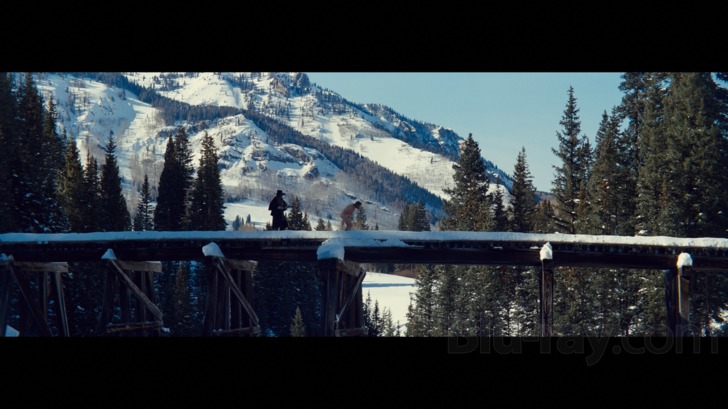
The Hateful Eight is presented on Blu-ray courtesy of Starz and Anchor Bay with an AVC encoded 1080p transfer in 2.75:1. As discussed above in the main body of the review, Tarantino went decidedly "retro" with this shoot, resurrecting Ultra Panavision lenses that hadn't been utilized in literally decades and shooting on 65mm film. Though I'm not sure whether this was sourced from 35mm reduction elements (the only way the general release version was seen) or from the DCP files (which I assume would have been sourced off the large format), the results are gorgeous and often downright stunning, especially when Tarantino and DP Robert Richardson (Oscar nominated for this film) venture outside. The film's opening moments display a subtle but effective color grading which tinges the snow covered hills in a light blue, and a blue or purplish tint tends to crop up repeatedly throughout the presentation. Interior sequences at Minnie's Haberdashery are often rather subtly skewed toward a buttery yellow ambience, and one of the pleasures of this presentation is how the grading is relatively nuanced (at least within the often aggressive environment that a lot of contemporary films employ). Despite these measures, detail is routinely fantastic throughout the film, where magical little moments like backlit snow (even in quite dark sequences) are beautifully detailed and precisely rendered. There are a number of other interesting moments that speak to Richardson's lighting finesse. Look, for example, at how Lincoln's letter magically glows when Warren pulls it out in the stagecoach early in the film. Later, when Mobray demands to see Ruth's warrant for Domergue, again there is an effulgent amber glow on the table which almost makes the document look like a holy parchment or something. The subtlety of the lighting effects tends to offer substantial shadow detail even in the kind of musty interior of Minnie's Haberdashery, and when the film bursts outside in the bright daylight, the palette and general detail levels are excellent. Fine grain levels are completely natural looking and encounter no compression issues, supporting what is a beautifully organic viewing experience.
The Hateful Eight Blu-ray Movie, Audio Quality 
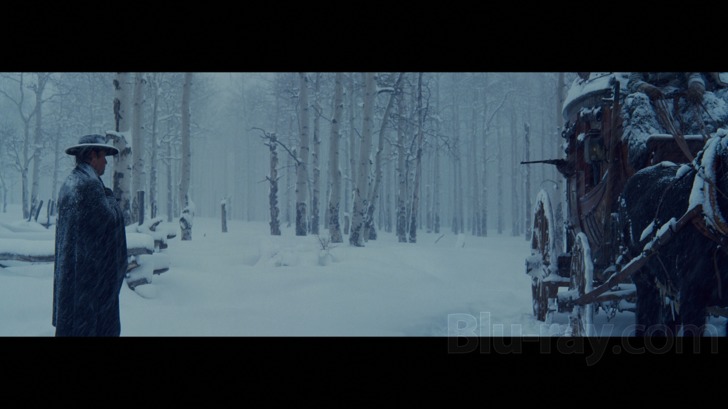
The Hateful Eight features a consistently immersive DTS-HD Master Audio 5.1 track the provides a glut of surround activity due to the fact that for the bulk of the film the story takes place while a ferocious storm is buffeting the landscape (and Minnie's Haberdashery) with regular gusts of wind. While some of the longish dialogue scenes within the lodge tend to offer only discretely placed ambient environmental effects to establish spatial relationships, the outdoor elements are often quite spectacular and mix effects, Ennio Morricone's sometimes odd but hugely enjoyable score (an Oscar winner), and dialogue quite winningly. Fidelity is fine throughout and there are no problems of any kind whatsoever to warrant concern.
The Hateful Eight Blu-ray Movie, Special Features and Extras 
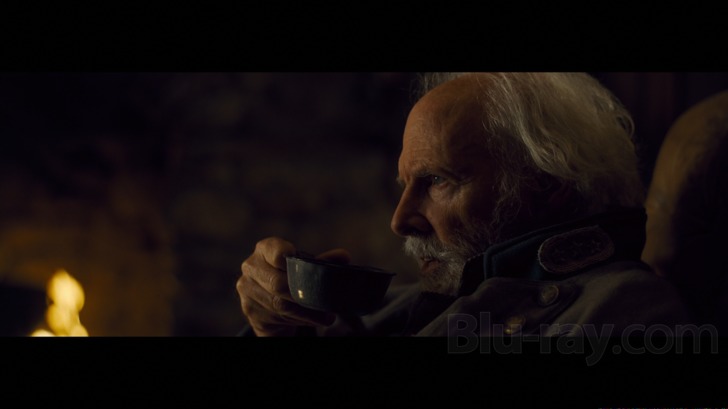
- Beyond the Eight: A Behind the Scenes Look (1080p; 4:58) is a brief and distressingly pedestrian EPK featuring interviews and snippets from the film.
- Sam Jackson's Guide to Glorious 70mm (1080p; 7:49) isn't overly lengthy itself, but has some fun info about the "retro" Ultra Panavision look of the film.
The Hateful Eight Blu-ray Movie, Overall Score and Recommendation 
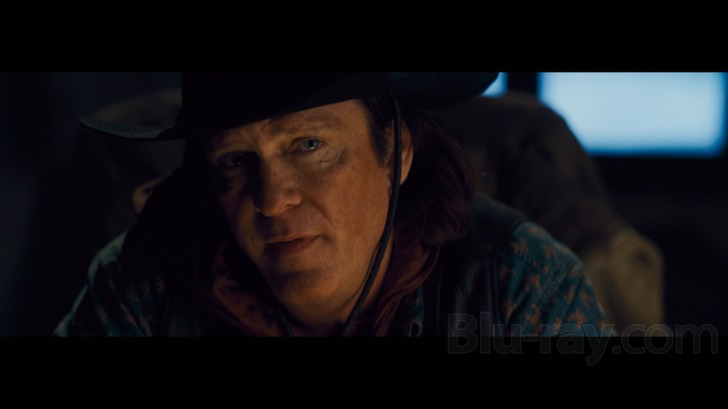
On one level The Hateful Eight is the very essence of a shaggy dog story, with Tarantino going off on a number of tangents which frankly could have been handled with a lot less detail. But that's part of what makes a Tarantino film so distinctive, isn't it? If the actual mystery here is no great shakes, the film is filled to the brim with such memorable characters that it hardly matters when all is said and done. I have to wonder if we're going to see a "Special Edition" of this film coming down the pike which includes the roadshow version (perhaps in 4K UHD?), for this release's supplements are decidedly on the paltry side. For those who don't want to wait, though, this release sports top notch technical merits and comes Highly recommended.
Other editions
The Hateful Eight: Other Editions

The Hateful Eight
Western Line
2015

The Hateful Eight
Ultra Panavision 70
2015

The Hateful Eight
w/ Bonus Content / Exclusive Lenticular Packaging
2015

The Hateful Eight
2015

The Hateful Eight
2015

The Hateful Eight
2015
Similar titles
Similar titles you might also like

Django Unchained
2012

The Nice Guys 4K
2016

Knives Out 4K
2019

The Trouble with Harry
Alfred Hitchcock Masterpiece Series
1955

Frenzy 4K
1972

Sherlock Holmes and the Voice of Terror
1942

The Sisters Brothers
2018

Reservoir Dogs 4K
30th Anniversary Edition
1992

Once Upon a Time in Hollywood 4K
2019

Kiss Kiss Bang Bang
2005

Shutter Island 4K
10th Anniversary Edition
2010

The Burbs
1989

American Psycho 4K
Uncut Version
2000

Killing Eve: Season 4
2022

Bad Times at the El Royale
2018

Killer Joe
Unrated Director's Cut
2011

The Guest
2014

Very Bad Things
1998

The Last of Sheila
Warner Archive Collection
1973

Desperado 4K
1995
